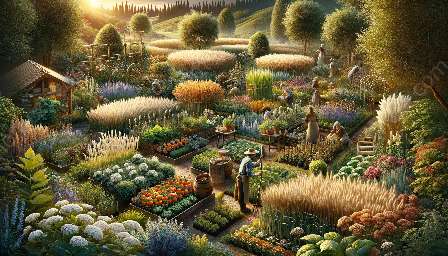Herbs have held a special place in human culture for centuries, revered for their culinary, medicinal, and aromatic properties. When it comes to companion planting and gardening, herbs play a pivotal role in promoting plant health, deterring pests, and adding beauty to landscapes. In this comprehensive guide, we will dive into the realm of culinary herbs, exploring their attributes, uses, and how they harmonize with companion planting and landscaping.
Understanding Culinary Herbs
Culinary herbs are plants valued for their flavor, fragrance, and various beneficial properties. Whether used fresh, dried, or preserved, these herbs elevate the taste and visual appeal of dishes.
Herbs can range from familiar favorites like basil, parsley, and rosemary to more exotic varieties like lemongrass, Thai basil, and epazote. Each herb boasts unique flavors and uses, nurturing a deeper connection to the earth and its gifts through gardening and cooking.
The Art of Companion Planting
Companion planting involves growing different plants together to provide benefits such as pest control, pollination support, and healthier soil.
When it comes to herbs, they can act as effective companions to many vegetables and fruits. For instance, planting basil alongside tomatoes can enhance the latter's flavor and help repel pests. This symbiotic relationship between herbs and other plants creates a balanced, thriving ecosystem.
The Marriage of Culinary Herbs and Landscaping
Herbs are not only invaluable in the kitchen but also serve as stunning ornamental plants. Their vibrant colors, enticing aromas, and diverse textures make them an ideal addition to gardens and landscapes.
When planning a garden or landscape design, consider integrating herbs to create visually captivating and functional spaces. For instance, lavender and thyme can be used as ground covers, enhancing the aesthetics of pathways and borders.
Popular Culinary Herbs and Their Benefits
- Basil: Known for its savory, sweet flavor, basil also repels mosquitoes and flies.
- Rosemary: This aromatic herb not only adds zest to dishes but also attracts pollinators when in bloom.
- Mint: With its refreshing aroma and taste, mint is excellent for soothing digestion and deterring pests when planted near vegetables.
- Lemon Balm: Known for its citrusy scent, lemon balm can be used in teas and cocktails and also attracts beneficial insects.
Cultivating a Herbal Haven
When gardening with herbs, it's essential to consider their individual needs for sunlight, water, and soil type. Most herbs thrive in well-drained soil, ample sunlight, and moderate watering.
Furthermore, incorporating compost and organic fertilizers can ensure the optimal growth of culinary herbs while contributing to a sustainable gardening approach. Mixing herbs within raised beds or container gardens can provide an efficient and visually appealing way to grow an abundance of flavors right at home.
Celebrating the Diversity of Culinary Herbs
The world of culinary herbs is vast and diverse, offering a plethora of choices for every palate and gardening preference.
By exploring the world of herbs and their compatibility with companion planting and landscaping, individuals can unlock a realm of both culinary and aesthetic delights. Discover the enchantment of herbs as they infuse life, flavor, and beauty into our gardens, plates, and everyday experiences.















































